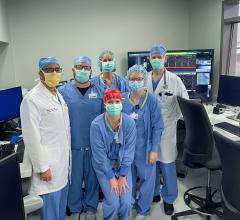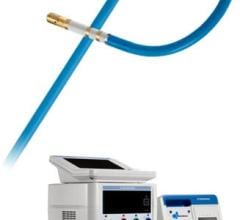
May 13, 2013 – New study data released at the Heart Rhythm Society (HRS) meeting last week validates the importance of contact force technology focused on improving the efficacy and safety of catheter ablation for the treatment of cardiac arrhythmias. Unveiled in HRS abstracts, the data also demonstrated the ability of the Endosense TactiCath ablation catheter to detect excessive contact force during robotic catheter navigation.
A key Endosense abstract at the society’s 34th annual HRS congress was presented by Moussa Mansour, M.D., director of the cardiac electrophysiology laboratory as well as the atrial fibrillation program at Massachusetts General Hospital. His abstract, “Application of Contact Force Guidelines Increases Durable Isolation after Pulmonary Vein Isolation for Paroxysmal Atrial Fibrillation,” provided evidence of the value of combining three contact force parameters to improve durability of pulmonary vein isolation (PVI) to treat paroxysmal atrial fibrillation (PAF). These include Endosense’s contact force (CF); Force Time Integral (FTI); and lesion index (LSI). Featured in Endosense’s new TactiCath Quartz device, LSI is a sophisticated algorithm that combines radiofrequency power, ablation time and contact force applied to the cardiac tissue in order to estimate lesion formation in real time.
Contact force guidelines were developed from Endosense’s TOCCATA study, a 12-month study completed in 2010, which found that clinical outcomes improve with CF > 20 g; and its later EFFICAS I post-market clinical trial, which not only revealed the value of FTI, but established the clinical practice guideline of an absolute minimum FTI of 400 gs per individual ablation lesion. Early results of the TOCCASTAR investigational devices exemption (IDE) study presented by Mansour underscored this guidance and showed that, in a subgroup that underwent a redo procedure, subjects treated with the combined CF guidelines of CF > 20 g, FTI > 400 gs and LSI > 5 showed the strongest improvement in pulmonary vein isolation rate: 80 percent when all criteria were fulfilled versus 46 percent when not all criteria were fulfilled.
“The data has clearly demonstrated the importance of contact force in achieving durable pulmonary vein isolation following the catheter ablation treatment of PAF,” said Dipen Shah, M.D., professor of cardiology at the University Hospital Geneva and co-author of the paper. “I believe these new CF guidelines have great potential to improve clinical practice and, ultimately, lead to better patient outcomes.”
Endosense CEO Jan Keltjens added, “Endosense has made significant strides since demonstrating the correlation between contact force and the durability of PVI for the treatment of PAF. In addition to establishing contact force guidelines, we have found that the long-term success of PVI is greatest when minimum CF is combined with minimum FTI and LSI parameters.”
In the abstract “Quantitative Magnetic Resonance Imaging Analysis of the Relationship between Contact Force and Left Atrial Scar Formation after Catheter Ablation of Atrial Fibrillation,” Dr. Christian Sohns of Kings College London examined the relationship between contact force achieved during catheter ablation for PAF and late gadolinium enhancement MRI (LGE-MRI) signal intensity as a measure for durable isolation following PVI. He found that increased LGE-MRI signal intensity correlates with increased FTI values, hence an important guidance for long-term isolation.
While low contact force can lead to ineffective lesions, excessive contact force may cause safety concerns. In the third Heart Rhythm 2013 abstract, “Complementary Techniques and Location of Excessive Contact Force Detection in the Left Atrium with Robotic Catheter Navigation,” Sarah K. Hussain, M.D., of the University of Virginia, Charlottesville, concluded that in a simulated bench experiment, Endosense’s TactiCath ablation catheter could enhance the capabilities of current robotic catheter systems in detecting excessive contact force wherever it occurs in the left atrium.
For more information: www.endosense.com


 March 27, 2025
March 27, 2025 








